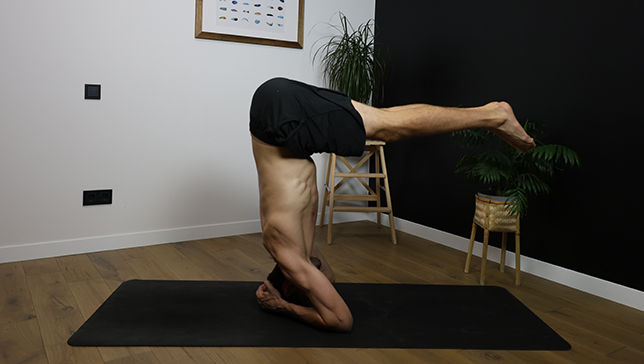Upward Standing Staff Pose - Urdhva Dandasana

Contents
Upward Standing Staff Pose or Urdhva Dandasana is a yoga pose that is also known as Upward Facing Staff Pose. It is a challenging pose that requires strength and stability in the arms, shoulders, and core.
Urdhva Dandasana is a challenging pose that can help to build strength in the arms, shoulders, and core. It can also help to improve posture and increase overall body awareness.
Engaging the core muscles (pulling the belly in), shoulders and arms, chest and diaphragm, along with the pelvis, the students can take their practice to the next level with Urdhva Dandasana (Upward Standing Staff Pose).
Urdhva Dandasana helps boost energy in the body and hence can be included in flow yoga sequences.
Pose Detail
- Difficulty: Advanced
- By Type: Arm Balance Yoga Poses, Balancing Yoga Poses, Strengthening Yoga Poses
- Body Position: Inversion Yoga Poses, Standing Yoga Poses
- By Benefit: Yoga Poses For Digestion
Step-by-Step Instructions
Benefits and Contraindications
Massages internal organs and improves digestion
Stimulating to the heart and circulation
Improves balance
Slows down ageing
Strengthens the arms, legs, and spine
Hernia
High or low blood pressure
Heart problems
Severe back, neck, stomach or head injuries
Menstruations and pregnancy
Modifications and Props for Beginners
- Use Blocks: Place two blocks behind your hips and rest your hands on the blocks. This can help to reduce the amount of weight that your arms need to support, making the pose more accessible.
- Practice Against the Wall: Stand with your back against a wall and place your hands on the wall behind you. This can help you to engage your arms and shoulders while still maintaining stability.
Useful Tips
- Engage Your Core: To help maintain stability in the pose, engage your core muscles by drawing your navel towards your spine. This will help to support your lower back and keep your hips lifted.
- Keep Your Shoulders Down: It’s common to lift your shoulders towards your ears in this pose. Instead, focus on drawing your shoulder blades down your back, away from your ears.
- Take Breaks: If you’re feeling fatigued, take breaks and come back to the pose when you’re ready. It’s better to rest than to push yourself too hard and risk injury.
Frequently Asked Questions
Urdhva Dandasana is an advanced pose that requires a lot of strength and stability in the upper body. It is not recommended for beginners unless they have a solid foundation in arm balances and have worked up to it with the help of a qualified teacher.
Yes, Urdhva Dandasana can be modified with the use of props or by practicing preparatory poses that build strength and stability in the upper body. Some modifications include using a block under the hands or practicing the pose with the knees bent.
To avoid wrist pain in Urdhva Dandasana, it is important to engage the muscles in the arms and shoulders and to distribute the weight evenly through the hands. You can also modify the pose by using a block or by practicing the pose with the forearms on the ground instead of the hands.
Common mistakes in Urdhva Dandasana include allowing the elbows to splay out to the sides, collapsing through the chest and shoulders, and not engaging the core muscles.
Variations
- Half Headstand
- Upward Facing Two-Foot Staff Pose
- Half Handstand At Wall
- Squeezing Pose
- One-legged Upward Standing Staff Pose